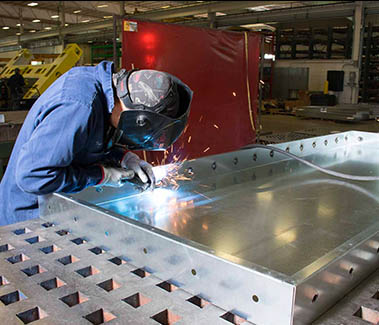Sheet Metal Fabrication has become the need of the 21st century as every industry you name, whether it is aircraft, railway, plumbing, manufacturing, or any other requires sheet metal to build products that can create a wave of technological advancement in the market.
The process of sheet metal fabrication involves turning flat sheets of aluminum or steel into metal structures by cutting, punching, folding, and assembling. One of the best things about sheet metal is that it can be easily cut and bent into any shape, that allows its utilization in an infinite number of applications. Holes and cutouts can also be created in the sheets using material removal processes to make varieties of parts that can serve their utilization in industries like construction, consumer products, furniture, automotive, aircraft, and HVAC.
If you search for “the best sheet metal industry near me,” you will come across various industries that are ready to provide you the desired sheet metal fabrication products, but choosing the one that can manufacture your products as per your exact specifications is crucial. Sangeeta Industries is one such reputed sheet metal Industries in Faridabad, which is efficiently fulfilling the demands of its customers for decades using the most suitable processes and materials.
The steel metal fabrication process can differ from case to case depending on the requirement of the design specifications, but the typical fabrication process remains the same.
Let us explain the steps involved in the sheet metal fabrication process:
- Designing: The sheet metal fabrication process begins by creating a design of the product need to be made. Design helps the manufacturer to understand the scope of the fabrication. The engineers create the final blueprints that specify the sheet metal product specifications that are used to manufacture the final sheet metal product.
- Cutting: In this step, large and thin sheets of metals are cut into the desired length to create small rectangular sheets using advanced cutting tools. The size of the rectangular sheet is according to the design of the final product. The process is usually carried out using shearing machines, but owing to the evolution of technology, manufacturers are now moving towards the laser, water jet, and plasma cutting methods.
- Punching: Here we come to the third and the most important step in the sheet metal fabrication. Different sizes and shapes of holes are created in the sheet metal with the help of punching machines so that the sheet metal can fit in the applications of various industries. To create holes with optimum precision, manufacturers can also use laser cutting technology.
- Bending: The sheet metal is bent at multiple angles and places using a machine called press brake. Bending is done to transform the metal sheet as per the given specifications of the product. But this process involves the biggest challenge, and that is managing spring back – when metal tries to get back its original flat shape. To prevent the metal to regain its original shape, overbending is done, but getting the bend at exactly the right angle needs good experience and excellent skills. If excess bending of the metal is done, then it may lead to cracking.
- Assembly: Once the sheet metal products are created by using the above-mentioned operations, then its time to assemble them. Most of the time, welding is done to assemble the metal parts in a precise manner. Other options other than welding are also available such as adhesive bonding and riveting.
- Finishing: After assembling metal parts, finishing is performed to add physical properties and appearance to them as per the requirements. The process may include cleaning, painting, coating, galvanizing, and others to protect the surface of metal products from rust or corrosion in different working environments.
- Quality assurance: Post completing all the above-mentioned steps, the final product goes through a strict audit to ensure that it is of the best quality. The design specifications are matched with the product specifications to find errors, and if in case any error is observed, then the piece is rejected or sent for correction. Once it is ensured the final product is exactly as per the requirements, then it is cleared for the next step.
- Packaging: This is the last step of sheet metal fabrication in which the final products are packed in precise packaging to ensure their safe and damage-free delivery to clients.



